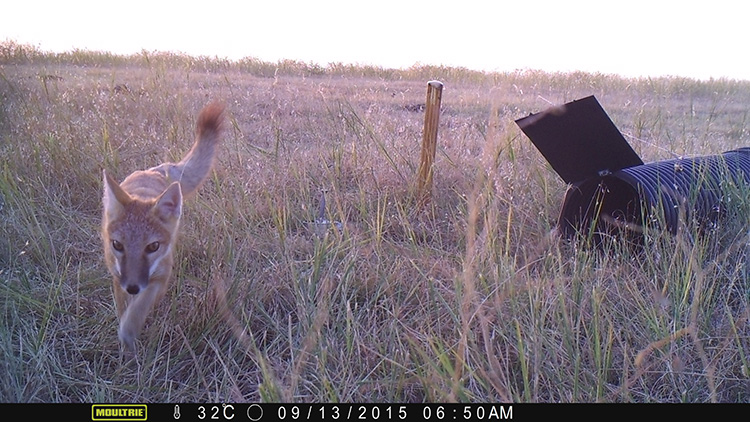
Although the swift fox once occupied nearly two-thirds of Nebraska, the at-risk species is now estimated to occupy just 20 to 25 percent of their historic range.
"Once common from western Canada to Texas, populations of swift fox have declined drastically since the settlement of the Great Plains," said TJ Fontaine, assistant unit leader of the Nebraska Cooperative Fish & Wildlife Research Unit.
Identifying where populations of swift fox exist is imperative to successful management of the species. Until recently, other than anecdotal information, little was known about the precise location of swift fox populations in Nebraska.
Fontaine and a group of multi-institutional researchers are working to change that.
"There hasn't been a scientific study of swift foxes in Nebraska since the 1980s," said Lucia Corral, applied ecology doctoral student. "Information on their ecological and geographical distributions is crucial for effective management, conservation planning and forecasting the status of these populations."
But in a state where 97 percent of the land is privately owned, acquiring the proper access to survey for swift foxes is challenging.
"Just getting permission to go look for swift foxes is an arduous task," Fontaine said.
Although nearly 150 landowners have agreed to let researchers look for swift foxes on their properties, that number represents a small piece of a much larger pie.
"Access on 150 properties is a lot, but when your study area covers 26,000 square miles of western Nebraska, you can imagine that there are a lot places we just haven't sampled," Fontaine said.
That's where students – or citizen scientists – enter the picture.
"As we work with students all of the time, they seemed like a logical connection between the research we were doing and the Nebraskan citizenry," Fontaine said. "Moreover, many of our students are from rural Nebraska and therefore relate to Nebraska's farmers and ranchers. That personal connection helps when asking a favor like allowing someone to go look for animals on your land."
Teresa Frink, chair of the applied sciences department at Chadron State College and one of the leading experts on swift foxes in Nebraska, began involving her students in the search for the elusive species several years ago.
"Dr. Frink has had more than thirty students set up sampling stations for swift foxes," Fontaine said. "The program was so popular with the students that we thought it was worth trying to increase the number of students we could engage."
Thanks to a grant from the Nebraska Environmental Trust, beginning this spring, select students in Introduction to Agricultural and Natural Resource Systems (AGRI/NRES 103) will be recruited to participate in the project.
"A goal for the AGRI/NRES 103 course is to help students connect scientific information to important issues and decisions to be made at an individual and societal level – including conservation of wildlife in the state of Nebraska," said Jenny Dauer, assistant professor of practice in science literacy. "This project will allow us to determine if skills students practiced in the course translate into a 'real world' scenario."
The researchers aim to have 10 to 15 students at UNL and CSC participate each year. Ideally, between 60 and 90 students will have worked on the project by its completion.
At the start of each semester, researchers will host two-day workshops at each institution to train their citizen scientists.
"During the workshop, students will learn the methodology for collecting data on where swift foxes are located in Nebraska, including where and how to set up camera trap stations and how to manage the data they collect," Fontaine said.
Acquiring that technical knowledge is just as important as fostering an appreciation for landscapes and wildlife, said Michelle Lute, postdoctoral research associate.
"The product of this research – the photographs themselves – allows students a glance into wildlife activity that people usually do not get to see," Lute said. "These visuals bring ecological concepts learned in the classroom to life."
The Nebraska Canid Project has received support from the Nebraska Wildlife Conservation Fund administered by the Nebraska Game and Parks Commission, the U.S. Forest Service, the Nebraska Department of Roads and the Nebraska Environmental Trust.
To learn more about the project, visit http://swiftfox.unl.edu.
"Nebraska is a big state, and we have been asked to look for a very small, very secretive animal," Fontaine said. "With the help of students from UNL and Chadron State, we feel we can overcome this challenge. The more students we can get who are willing to spend time setting up cameras on their friends' and family's farms and ranches, the more of the state we can cover and the better we can address the questions we were asked to answer."
— Mekita Rivas, Natural Resources
More details at: http://go.unl.edu/sgtq